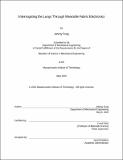Interrogating the lungs through wearable fabric electronics
Author(s)
Fung, Johnny(Johnny Z.)
Download1197972653-MIT.pdf (454.0Kb)
Other Contributors
Massachusetts Institute of Technology. Department of Mechanical Engineering.
Advisor
Yoel Fink.
Terms of use
Metadata
Show full item recordAbstract
Lung disease such as pneumonia is one of the leading causes of mortality throughout the world. Currently, many screening techniques performed on the lungs are too expensive, cumbersome, not continuous, and not easily understood without proper medical training. Furthermore, with the pandemic of Covid-19, the demand of screening patients in a non-invasive method has skyrocketed. Stethoscopes require training to understand the abnormalities when listening to the sounds the body makes, also known as auscultation. In this thesis, we sought to develop a lightweight, flexible, wearable fabric that can perform auscultation on the lungs. These fibers were created using the thermal drawing process that allows the fibers to perform various functions depending on the materials used for the draw. The initial solution used a conductive fiber created by injecting a liquid metal into a hollow fiber. This was deemed inadequate as the fiber generated a lot of noise and was only capable of detecting respiratory rates on a body with minimal movement. With minimal movement, this destroyed the purpose of having the fiber be mobile and flexible. The second solution utilized a nanostructured piezoelectric fiber to listen to the sounds the body makes. The piezoelectric fiber was successfully able to detect the sound of a heartbeat, but the lung sounds were overwhelmed due to the loudness of the heart. These sounds were measured with the fiber placed on the chest. For future studies, the fiber will be placed in various locations on the body to determine the optimal location for auscultation of the lungs. Furthermore, the shape of the fiber network will be optimized, creating an amplifying effect in the direction of interest. This will be an attempt to minimize the noise coming from the heart and focus more on the sounds the lung makes.
Description
Thesis: S.B., Massachusetts Institute of Technology, Department of Mechanical Engineering, May, 2020 Cataloged from the official PDF of thesis. Includes bibliographical references (page 17).
Date issued
2020Department
Massachusetts Institute of Technology. Department of Mechanical EngineeringPublisher
Massachusetts Institute of Technology
Keywords
Mechanical Engineering.